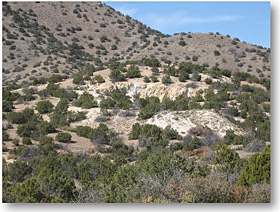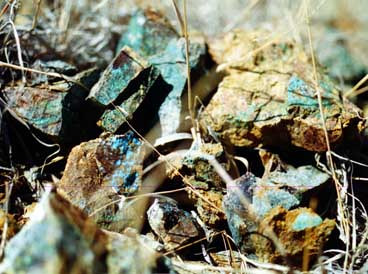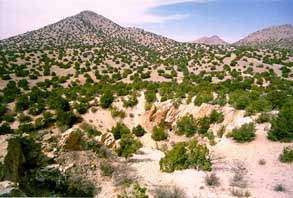Turquoise and the Park
The Name
In most European languages the bright blue or blue-green stone is called "Turkish" because at the time of its introduction to Europe it appeared to have originated from the country of Turkey. In fact those early specimens came from lands beyond the country of Turkey, but passed through that country on their way to Europe. 'Turkish' in the lingua franca (Frankish or French tongue) of the day was "turquois" or "turquoise".
As early as 1652, Thomas Nicols, an English writer, referred to "the beauty of a Turky stone". In ancient Greek it was borea, after the deep blue color of the northern sky; in Latin, turchus or turchius. In Spanish it is known as turquesa and in German, Türkis. In Japanese it is (by extension) turkodama. Turky stones in Europe were probably in fact mined near Nishapur in Persia.
Turquoise, called mafkat by the ancient Egyptians, was obtained from the oldest known mines in the world, which are on the southwest edge of the Sinai Peninsula. As recently (!) as 3,000 years ago these mines were superceded by other sources.
In the New World it was called chalchihuitl or xiuitl ['xiu'=blue], which are Nahua words. Nahuatl is the language of the Aztecs and related tribes of central Mexico. "Chalchihutil" was used for both jade and turquoise. For Native Meso-Americans 'chalchihuitl' was green jade in the tropical south where there was no natural turquoise, and green or bluish turquoise in the more arid north.
In response to a question about the root components of "chalchihuitl", Dr. John F. Schwaller of the University of Minnesota, Morris, has provided this explanation:
"The Nahuatl word for emerald (and turquoise and jade and any other precious green stone) is chalchihuitl. It cannot be broken down any further. It looks as though it might be made up of two parts: chal + chihuitl, but it isn't. It is an independent morpheme. All of our early sources are uniform in describing it as a word for green stone or emerald.
Chalchihuitl is a very flexible term, as noted. It can really be used for any precious green stone and thus became associated with turquoise and jade, although there is a real range of colors, hardness, etc. among those three.
Metaphorically it also has connotation of preciousness. It appears frequently as "my precious green stone, my beloved."
The Nauhua colonial name for the Turquoise Hill on the north side of the Cerrillos was Cerro Chalchiquite. In the Argentine Andes the valley of turquoises is recorded as Valle de Chalchaquies.

One of the smallest, but at the same time most important, of the Cerrillos Hills is Mount Chalchihuitl, the site of numerous prehistoric turquoise mines. The early Spanish visitors to New Mexico did not value the mineral (there is no "Cerro Turquesa") but their central-Mexico allies and fellow-travelers, primarily Nahuatl-speaking Tlascalans, esteemed turquoise above all other stones. Hence, we have inherited through the Spanish records the Tlascalan name for this 'turquoise hill'.
On January 20, 1978, Mt. Chalchihuitl was enrolled into the New Mexico State Register of Cultural Properties.
There is a second Tchalchihutl in New Mexico, yet another source of turquoise, in Cíbola County near the town of Bluewater. These Tchalchihutl Mines are also on the New Mexico State Register of Cultural Properties.
The Chemistry
Practically all significant deposits of turquoise are found in arid or desert regions of the world, and commonly within 100 feet [30 meters] of the surface. The exceptions, such as a turquoise lode at the 1200-foot [365 meter] level of a mine in Bisbee, Arizona, are remarkable and unusual.
"Turquois occurs at comparatively few places on the globe, and strangely enough is confined almost exclusively to regions of barrenness and aridity. It is also a remarkable fact that, with a few unimportant exceptions, no occurrence is now known near which traces of prehistoric mining have not been discovered." J.E. Pogue, THE TURQUOIS, 1915, reprinted 1972
Cu Al6 (PO4)4 (OH)8 · 4H2O
Turquoise is an hydrous phosphate of alumina containing a little copper. It has a blue, or bluish green, color, and usually occurs in reniform [kidney-shaped] masses with a botryoidal surface.
It is a secondary mineral, formed by water percolating through existing minerals; altered rocks containing copper and apatite [a native crystalized phosphate of lime], the source of the phosphate. In the Cerrillos Hills turquoise occurs in veins and thin seams that fill the cracks in the matrix stone, and sometimes as nodules.
" ...a phosphate of aluminum carrying small quantities of copper and iron, to which its color is due, and with variscite, a green mineral of similar character but of less value and beauty, is the only phosphate to find a place among the precious stones." J.E. Pogue
The creation of the turquoise in the Cerrillos Hills occupies but a chapter, and a late one at that, in the story of the creation of the Hills. The Cerrillos Hills are the remnants of a spate volcanism that started about 34 million years ago and lasted 5 million years or so. That volcanic material, which comprises much of the Cerrillos Hills, is called the Espinaso.
The Espinaso volcanics are more precisely the extrusive equivalents of the stocks [vertical mineral bodies] and laccoliths [horizontal mineral bodies] of the Ortiz Porphyry Belt (which includes the Cerrillos Hills). Therefore the age of the Espinaso volcanics more or less has the same range as the suite of intrusive rocks (34 to 30 million years), and the youngest Espinaso would represent the last hurrah (or belch) of the igneous event. However, it should be remembered that last erupted generally means first eroded. So the Espinaso volcanics that we see probably do not represent the last phase.
The last hurrah of the igneous event is really the base and precious-metal mineralization, occuring as fracture fillings and replacements that probably occured about 29 million years ago.
The turquoise is a much later, supergene event [natural mineral enrichment and deposition at the subsurface water table], associated with the oxidation of pyrite, production of sulfuric acid, and remobilization of phosphorous and copper. Turquoise [in the Cerrillos] probably formed no earlier than the late Pliocene, perhaps 3 or 4 million years ago. [Stephen R. Maynard, 2002]
Turquoise is not a hard mineral. It is approximately as hard as feldspar and can be easily scratched by quartz. It can be brittle and susceptible to fracture, similar to ivory. It may discolor from heat, oils, soaps, chemicals, perfume, and even exposure to the sun and air. For all these reasons, turquoise employed in jewelry is usually treated to enhance color or to seal it against contaminants.

The Color
The blue color of turquoise comes from copper, the green from iron. As turquoise dries out it fades, as was described by W. E. Hidden in 1893: "At depths below twenty-five feet the turquoise when first found is of a magnificent, almost ethereal, tint of blue, but this rapidly fades after it is detached from its matrix and becomes dry. I have seen it as deep blue as indigo and then fade gradually to a 'robin's-egg' shade."
Though there is some evidence that prehistoric mining of turquoise was sometimes done by fire and water (building a fire on the rockface and then dowsing it with cold water, causing the rock to crack) this procedure invariably causes the turquoise to discolor. In the Cerrillos Hills the great number of porphyry mauls and hammerstones, some as heavy as 20 pounds [9 kilograms], suggests that brute force was a popular mining technique.
For centuries the color of turquoise has been enhanced by the application of animal fats such as butter or tallow. Prussian blue is known to be used to turn inferior stones into apparently superior ones. Since the time of ancient Egypt, turquoise has been imitated through the use of glass, enamel, other minerals such as variscite, lazulite, lapis lazuli, malachite, azurite, and others. In modern times, synthetic turquoise, often containing the same chemical components, is difficult to distinguish from the natural stone. This is especially true when a filigree of matrix material is artfully included. In an effort to guarantee quality and authenticity, some turquoise companies resorted to engraving a trade mark on the back of each of their stones. Some of the trade marks were [Fayette Jones, 1905]:
X = Gem Turquoise and Copper Company
T = Toltec Company
A = American Turquoise Company
O = Azure Company
< ---<< (arrow) = Himalaya Company
The practice in the American Southwest of setting turquoise in silver, for which the Navajo and Zuni are so renowned, began only in the 1880s. Prior to that time the stone was either used by itself, affixed to wooden forms or bones, or drilled and threaded as a necklace or pendant. Southwest Native American silversmithing, which began with the Navajo, dates only from 1860.
The Lore
The earliest Old World references to the blue-green stone confabulate jasper and turquoise. Pliny's iaspis aerizusa [jasper air-colored] appears to be what we now call turquoise. Pogue gives a reference from First Century A.D. Rome: "Wear on your finger a jasper shining blue-green like the turquois and you will be cured from the disease (i.e. epilepsy); it is of great value..."
From an eleventh century Persian manuscript: 'Piruzeh' (Persian for turquoise) is a stone without brillance, but one regarded as auspicious and lucky on account of its name, which signifies victorious or fortunate.
Marco Polo states "...the turquois possesses the quality of becoming clarified or bright in time of serene and clear weather, and vice versa."
Then this charming quote from Bulwer, 1665, in reference to either jade or turquoise: "The Brazilians have their lips bored wherein they wear stones so big and long that they reach to the breast... great Jasper stones being a kind of bastard emerald inwardly flat with a thick end because they shall not fall out; when they take out the stones they play with the tongue in the holes, which is most ugly to behold, for that they seem to have two mouths one above the other."
Sahagun, in 1888, says of the Aztecs; "Teoxiuitl is called turquois of the gods. No one has a right to possess or use it, but always it must be offered or devoted to a divinity. It is a fine stone without any blemish and quite brilliant. It is rare and comes from a distance." And further; "There is another medicinal stone called xiuhtomoltetl (from xiuhtomolli, turquois, and tetl, stone), which is green and white at the same time like chalchihuitl. It is very beautiful. Its moistened scrapings are good for feebleness and nausea."
"For centuries, apparently, there was rather general belief that the color of the stone depended on the health of its owner. It was further believed by some that turquois lost its color if worn by lewd or immodest persons and that fidelity of a lover could be tested by this means." [Stuart A. Northrup, 1959]
Chalchiuhtlicue, meaning "green-stone skirt", is the Nahuatl name for the goddess of rivers, springs, and lakes. She had power over whirlwinds and hurricanes. She was the wife of the rain god Tlaloc, and was also worshiped as a goddess of childbirth and protector of children because of the water that breaks before a woman gives birth.
For Zuni, perfect blue turquoise symbolizes the male, and off-color turquoise, the female. In one Hopi legend turquoise is the excrement of lizards. For Apache, turquoise is associated with the bringing of rain and could always be found at the end of a rainbow. Turquoise has many values in Navajoland, including an offering to appease the wind, which blows in search of the stone. Also, blue is the color of south, and is associated with Tsotsil, the great mountain of the south [Mt. Taylor]
The Archaeology
In the New World the earliest evidence of turquoise is associated with the South American Cupisnique culture after 900 B.C., and in the Middle Pre-Classic Valley of Mexico, 700 to 650 B.C. The oldest well-documented record of turquoise in the present United States is from the Snaketown ruin in southeastern Arizona, where two ornaments have been dated from before 300 A.D.
The real florescence of the prehistoric turquoise industry in the Southwest starts soon after 900 A.D. The sum total of all the prehistoric turquoise found in the Southwest dated prior to 900 amounts to less than one percent of the whole. [D.H. Snow 1973]
In Chaco Canyon, northwestern New Mexico, turquoise was in use at least by about 750 A.D., and excavations at Chaco of features dating from about 900 to 1150, the glory days of the Chaco Culture, have so far uncovered more than 100,000 pieces of turquoise. In the heart of Chaco Canyon, at Pueblo Bonito alone, more than 65,000 artifacts, fragments and unworked pieces of turquoise were found. There are no known prehistoric mines in this area; all that turquoise was imported.
In addition to Cerrillos, four other prehistoric New Mexico turquoise mining districts have been identified, all of them in the southwest corner of the state: Burro Mountain and the Eureka District, both in Grant County, and Red Hill and Orogrande in Hidalgo County. Over 200 pre-European turquoise mines have been documented in New Mexico, Arizona, California, Nevada, Utah, and Colorado. Early turquoise mining also occurred in Mexico, in Baja California, Chihuahua, Coahila, Guerrero, Jalisco, Sonora, and Zacatecas. [Levine & Goodman]
S.H. Ball, commenting on the prehistoric trading of turquoise, says "...New Mexican turquoise reached Mexico City and the Mayan cities, and the early trade in Southwestern turquoise extended from the West Indies and Yucatan on the south to Ontario on the north... and from California on the west to Mississippi and Arkansas on the east."
Hernando de Soto, in the lower Mississippi valley in 1542, found "...some turquoise and shawls of cotton which the Indians gave them to understand by signs, were brought from the direction of the sunset." [J.C. Kelly, 1955]
Several prehistoric Southwestern quarries and mines show small campsites at or nearby them, utilized by a small number of people, but almost without exception there are no permanent habitations associated with any Southwestern mines. However, villages were usually located a short distance away. It is inferred that, just as a salt bed was not considered the property of any one tribe, so a turquoise lode, the gift of the earth, was not owned by anyone.
Not far from the Chalchihuitl turquoise mine in the Cerrillos are the remains of a small, 5-structure mining camp that has been tentatively dated 900 to 1140. It is proposed that this camp was occupied seasonally by turquoise miners, and that a significant portion of their product was destined for the Chaco culture area.
Better known and much larger is the pueblo of San Marcos, approximately 2½ miles east of Mt. Chalchihuitl. San Marcos, one of the largest prehistoric pueblos in the United States, with approximately 2,000 ground-floor rooms, is assumed - from its beginnings around 1300 to its abandonment during the revolt of 1680 - to have controlled to some extent the turquoise and lead mines of the Cerrillos Hills. There is an abundance of turquoise debitage (waste flakes) at San Marcos, indicating quantities of turquoise were processed there, but not a great number of finished turquoise pieces.
As referenced by David Snow, an analysis of potsherds found at the O'Neil Blue Bell turquoise pits to the south of Mt. Chalchihuitl has determined that 75% of them came from San Marcos Pueblo, and that 95% of them date from 1300s through the 1600s.
The San Marcos Pueblo site is the object of two ongoing, separate but cooperative, archaeological projects by the University of New Mexico and the American Museum of Natural History.
The Cerrillos lodes are recently claimed by the Santo Domingo Pueblo through inheritance from the former Tanoan or Keresan owners, some of whom at the time of the Pueblo Revolt (1680) joined with that pueblo. [Lange and Riley, 1966] Of the pueblos existent today, Santo Domingo is one of the closest, geographically, to the Cerrillos turquoise mines.
POGUE ON THE CERRILLOS
Joseph E. Pogue's THE TURQUOIS: A STUDY OF ITS HISTORY, MINERALOGY, GEOLOGY, ETHNOLOGY, ARCHAEOLOGY, MYTHOLOGY, FOLKLORE, AND TECHNOLOGY was published in 1915 by the National Academy of Sciences, and it remains one of the most exhaustive treatments of a single mineral ever, in any language. In 1972 the Rio Grande Press published a reprint of the great work, with some additional material. If there is a Bible for turquoise, this volume is it.
(The following information is taken from the writings of Joseph E. Pogue)
The strata of the area have been intruded by a series of monzonitic stocks, plugs, laccoliths, sills, and dikes. The erosion-exposed remnants of these bodies form the Cerrillos Hills. The most important deposits of turquois in the United States, from the point of view of their history and past production, are within the Cerrillos mining district, Santa Fe County, in the north-central portion of New Mexico...
Turquois has been mined extensively at two localities 3 miles apart. The first is situated on Turquoise Hill, 6 miles NE of Cerrillos, and includes the Tiffany and Castilian mines owned by the American Turquoise Co. of New York. The second occupies the slopes of Mount Chalchihuitl, a low knob near the center of the hills and about a mile east of Grand Central Mountain, and is now abandoned. Other localities in the neighborhood have been more or less exploited; some good material has been obtained from workings three-fourths mile SE of Mount Chalchihuitl and from claims one-half mile NW of Mount Chalchihuitl.
Mount Chalchihuitl is the site of the most extensive prehistoric mining operations known on the American continent. The extent of the workings is "truly marvelous"; the whole north side of the hill has been quarried out, while less extensive excavations are found in other parts of the so-called mountain...

William P. Blake, the first geologist to visit Mount Chalchihuitl, described it in Journal XII, the entry of August 29, 1857. The following is Blake's complete journal entry for Mt. Chalchihuitl. [] indicates indecipherable text.
Chal chee wee te
"A great chasm or excavation, basin shaped, with projecting crags and precipices. 200 feet deep - 300 wide - an enormous excavation into the solid rock and a pile of debris equally enormous. Trees growing in the bottom and at the sides, 20 feet high pines & very old. The rocks have caved in. A cave or shelter cut into the crags where Indians even now lodge.
"Leaving the arroyo we ascended the slope of the hill following a foot trail among the cedars & gradually ascending until we reached the brink of a precipice which stopped our progress. Here we dismounted and clambering down among the crags looked off into an enormous basin shaped excavation below in the bottom and along the sides of which pine trees were growing. This excavation is nearly circular and is bounded on three sides by vertical precipices of rock, rugged and supporting trees here and there in the crevices.
"I was so much struck with the extent of this singular excavation that it was some minutes before I could believe that it was the work of men alone and for an ornamental stone whatever it might prove to be. I looked in vain for traces of a mineral vein or bed of ore which might have attracted miners but there were none. In extent this opening is not not less than 300 feet in length and breadth and 200 feet deep and it must have been made the greater part of it centuries ago. The immense heaps or debris of the rock which has been removed is strewn out on one side and forms quite a hill which is over covered with pines - sufficient evidence of the antiquity of the opening. This is not the only pile of rocks which have been removed they are found on all sides and in most places are covered with lichens, gray with age. All the rock appears to have been broken up into fragments not larger than the fist or of eggs and then carried out and turned over the bank of refuses precisely as is done by the miners with their [] at the present day.
"The great opening is surrounded by several of less magnitude but - yet - quite extensive and the result of much hard labor. That such an extensive excavation and breaking away of the hard rocks can be the work of Indians without powder seems incredible but such it undoubtedly is. It cannot have been worked for any of the metals and the evidence presented at the locality is sufficient to show that it was not made in pursuit of either gold or silver but that it was made solely to procure the chal chee wee te. Looking carefully among the debris I found small fragments of the blue stone which I was assured is the much prized chal-chee-wee-te it resembled Turquoise which a subsequent careful examination found it to be. It occurs only in thin seams or veins traversing the solid rock and I should judge that it is rarely over 3/4 of an inch in thickness. Several masses of the old debris remained long ago show the mineral in blue spots and thin scales on the surface but specimens freshly broken out have a greenish color and are different from that of the turquoise in common use in jewelry. It is probable that specimens are seldom over the thickness mentioned but some fragments nearly half an inch in diameter may have been obtained.
"The rock is a white or rusty, sandstone much hardened and changed by heat. In some places it appears to shade off into an [] or prophyritic rock the line of separation not being defined.
"The locality is still frequented by Indians and the cave is blackened by the smoke of their camp fires and is partly sheltered at the opening by a pile of cedar boughs. A bed of green cedar was also found inside and a great heap of ashes where the fire is generally made. They appear to work among the ancient debris which in some places is turned up and covered with pits or holes. Around some of these pits fragments of the mineral were found in their seams and crust on the rock. It is probably Turquoise." (W.P. Blake, 1858)
In the words of Silliman,
"The observer is deeply impressed with the enormous amount of labor which in ancient times has been expended here. The waste or debris excavated in the former workings covers an area which the local surveyor assured me extends by his measurement over at least 20 acres. On the slopes and sides of the great piles of rubbish are growing large cedars and pines, the age of which... must be reckoned by centuries." (Benjamin Silliman, Jr., 1881)
According to measurements made by Sterrett in 1911, the main pit is about 130 feet deep on the high side, 35 feet deep on the low side, and 200 feet across, and the debris therefrom covers about 2½ acres. Many stone hammers and other primitive implements have been found in the debris of the ancient workings.
Ancient excavations have also been found at the other points modernly worked and at several places in Turquoise Hill they exceed in extent the recent excavations.
The immense excavations at Cerrillos are of great antiquity, and it seems beyond reasonable question that the greater portion was executed before the advent of the Spaniards. Indeed, this deposit must have supplied much of the turquois which was so widely used in pre-Spanish times, not only in the Southwest but in Mexico as well, for no other sources are now known at all adequate to account for the quantities employed.
